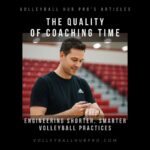Foundations
Effective coaching starts with understanding the integral relationship between technique and gameplay. Rather than viewing them in isolation, we must recognize how they constantly inform each other. Players develop technical skills through experience within the game, while the evolving strategic and tactical dimensions of gameplay require players to expand and refine their techniques.
As coaches, we must take a player-centered approach that meets athletes where they are and helps them build in a customized way from their existing strengths and weaknesses. This requires observing and listening closely as players practice and compete to understand their developmental needs. It means avoiding rigid technical models about how skills “should” be executed or imposing our own preferences. Adaptability is key – no two players learn or move exactly alike.
Relationship between Gameplay and Technique
Gameplay situations dictate the technical needs that arise for players. For example, serving against a strong passing team demands different technical precision than facing a weaker defender. Tactical choices within a match also change players’ technical requirements. The specific height, speed, and placement of sets requires appropriate technical adjustments from hitters.
Rather than isolated skill development, our training must help players recognize cues amidst complex game situations and adeptly apply techniques. Even individual skill drills should aim to mimic gameplay contexts. By consciously focusing on perceiving and feeling key elements of a technique within realistic exercises, players can better translate skills to competition.
Player-Centered Approach
Each player brings a unique athletic background and motor learning experience. Aspects like height, explosiveness, coordination, and court position strongly impact optimal technical models. Two players may develop distinctly effective hitting approaches to suit their abilities. Rather than imposing rigid ideas about proper form, we must observe individuals’ natural movements and help them refine their personal mechanics.
Building trust and cooperation forms the foundation of a player-centered approach. Athletes must know the coaching staff has their best interests in mind. Clear communication about the purpose behind training approaches is vital. Players are more likely to buy into challenging new drills when the potential benefits are explained respectfully. Giving players agency and inviting dialogue around skill development fosters partnership.
Shared Goals and Collaboration
Productive player-coach relationships hinge on common objectives. We must convey that suggested techniques aim to help athletes perform their best, not merely satisfy our stylistic visions. Players also desire success – if they believe a new skill truly offers an advantage, they will dedicate themselves to perfecting it.
Presenting skills in context is key; athletes need to perceive genuine usefulness, not just abstract ideas about quality movement. For example, making a subtle arm swing adjustment may better disguise hit directions. Framing advice around its functional impact stimulates greater effort and engagement. Athletes must understand why certain techniques support shared goals.
Coaching is always a two-way exchange. While the staff provides structure, guidance and resources, consistent input from players helps modify training plans. Watching skills sink in – or falter – against challenging opponents reveals what works, what needs refinement, and what methods best facilitate learning. Players’ direct feedback helps evaluate effectiveness.
Analysis and Evaluation
A thoughtful, analytic approach builds the foundation for player development. Careful observation during competitions reveals strategic and technical patterns. Statistics and video study quantify individual and team performance trends. Tracking this data over time allows tailored training to target priority skills and situations.
Equally important is regularly circling back to evaluate and reassess. Review previous matches to determine what technical elements transferred successfully to gameplay and where breakdowns occurred. Avoid over-attributing outcomes solely to execution; rethink the appropriateness of preparation plans given results. Be willing to question initial assumptions. Did prescribed techniques align optimally with players’ innate abilities or merely reflect comfortable coaching habits?
Dedicate time to self-evaluation of coaching effectiveness, not just player critiques. Survey athletes anonymously to understand engagement levels, sources of motivation and burnout. Solicit suggestions around drill pacing, feedback methods, communication style preferences. The coach’s role is an ongoing experimentation to determine what works.
Adapting Approach to Players’ Needs
Designing productive training cycles requires tailoring to athletes’ capabilities and backgrounds. Younger players likely need more holistic skill exposure before specialization. Take care not to overwhelm developing coordination with overly complex exercises or excessive corrections – build gradually. Conversely, seasoned players have the neural pathways to handle advanced footwork patterns and tactical decisions.
Pushing comfort zones cannot be haphazard; players require preparation to handle new challenges. Build the physical capacities with strength work and pacing. Break down novel skills before integrating them into high-intensity gameplay. Recognize that setbacks will accompany growth in skill level and decision making autonomy. Manage frustration and reinforce effort.
Monitor fatigue, soreness and moods closely given the physical and mental exertion of volleyball. Scale back sessions proactively at the first signs of breakdown rather than pushing through exhaustion. Carefully scheduled recovery allows adaptation. Multiday training cycles factor in both concentrated loads and intentional rest to maximize long-term development.
Developing Technique
Once a strong coach-player partnership is established through a learner-centered approach, the real work begins in developing athletes’ technical skills. Gameplay reveals priority areas for growth; our challenge is structuring productive training to expand capabilities. This requires understanding critical movement patterns, stimulating multisensory awareness, providing external feedback and fostering creativity within suitable progressions.
Recognizing Technical Needs from Gameplay
In-match analysis and statistics highlight areas for skill development. Where do effort levels fall off? Which attacking zones see lower kill percentages? What specific serve receive, blocking or defensive reactions prove problematic? Breakdowns indicate situations to prioritize training.
Catalogue individual tendencies through careful video study and notation. Note each hitter’s favorite shots by location, speed and height. Does the setter reliably disguise dump attacks? Mark serving toss patterns and zones. Chart typical blocker reactions against fakes. Identifying individual technical habits lays the foundation for tailored improvement plans.
Statisticians provide useful data, but also watch entire matches to pick up on subtle strategic adjustments. Did the passer adjust their platform angle or take extra lateral steps when facing middle-driven jump serves? When did the opposite transition to swing blocking against sharp angle hits? Only those on court fully experience evolving scenarios.
Specificity in Training Sessions
Gameplay observations determine technical training priorities, while statistics verify outcomes. But practice demands specificity. Workload, movement patterns, speed and stakes should precisely simulate those in competition. Narrow isolated skill repetitions, while mentally straightforward, rarely transfer outside scripted conditions. Design sessions to prompt split-second recognitions and reactions that builds instinct.
Maintain the complex environment with nested drill progressions. Begin with full 6 vs 6 gameplay incorporating serve receive, setting, attacks, blocks and floor defense – the coach can dictate point scoring specifics to direct focus. Then carve away layers with smaller sided games to concentrate on key phases like hitter-blocker battles or backcourt transition play. Allow time to replay base 6 vs 6 activity to integrate refined skills.
Further enhancement comes through individual analysis video sessions, ideally with instant replays available court-side. Freeze a previous attack attempt just before contact to diagnose movements and cues. Show super slow motion of a middle hitter’s hip turn. Contrast swing blocking footwork on perfectly vs poorly timed stuffs. Making corrections by immediately reattempting the same scenario cements learning.
Stimulating Awareness and “Feeling”
Game execution requires engrained muscle memory, but deliberately attending to technique generates lasting improvement. External feedback guides adjustments, while specially designed drills shift focus inward. The goal: stimulating proprioception – athletes’ conscious awareness of body positioning through sensations. Sharpening “feel” elevates performance potential.
Verbal cues prompt internal focus on specific movement phases, accompanied by tactical instruction on when applying certain skills. For serving: “sense the smooth rhythm as you drive forward to the toss”. On blocking: “feel the force transmission as your penetration foot plants”. Follow attempts with queries: “How did the timing of your stride feel relative to the set?”
Reduce sight inputs with blindfold drills to heighten non-visual awareness and responsiveness. Vary court surface textures or introduce padded obstacles to navigate. Perform familiar skills with restrictive resistance bands or weights. Introduce controlled destabilization – adjust movement speed, alter spatial references, impose reaction commands – then restore stability. Such out-of-habit activations awaken dormant proprioceptive pathways.
Providing Feedback and Using Cues
External feedback accompanies focused sensory work to ingrain good mechanics. Verbal cues prompt quality technique, while kinematic signals mark ideal performance standards. Validate players’ intrinsic diagnostics: “Your timing intuition is spot on. The slower toss rhythm disrupted your final approach”. Ask questions to stimulate joint problem solving: “What do you think caused the mishit?”
Words alone rarely suffice; model proper executions for visual imprinting. Demonstrate technical elements at net then have players imitate without the ball. Use court lines to establish spatial references. For example, lay target cones showing optimal post-block foot signings relative to the 3-meter line, making adjustments visible. Mark zones on court representing service toss contact points resulting in precise serve placement.
Set defined metrics – post contacts, approach steps, specific rally events – then measure against them. Video filming from multiple angles simplifies movement study. Share clips of athletes successfully executing skills for self-modeling. Set up court-side angle mirroring to watch technique simultaneously with playing. Checkpoints create recognizable achievement as skills develop complexity.
Individualization and Creativity
There exists no uniformly correct hitting approach, set trajectory or defensive platform – only optimal patterns for each athlete’s abilities. The essential decathlon becomes far less exciting if everyone employs identical techniques. Leveraging players’ unique attributes expands possibilities within a system. Provide space for them to showcase their signature style.
Nudging individuals outside comfort zones opens new frontiers, so regularly introduce skills slightly beyond current capability. But stay attuned to levels of control; excessive difficulty risks reverting to outdated habits. If breakdowns occur, promptly relieve pressure to prevent anxiety. Then revisit foundational drills restoring competence.
Celebrate creativity within role responsibilities. Encourage reasonable improvisation: the setter turning a shanked pass into an unexpected shoot set for the weak-side hitter; the libero initiating clever overhand passing sequences to throw off server reads. Have attackers disguise tendencies for a few plays each match, then discus outcomes. Foster experimentation mastery within a structured team framework.
Tactical Awareness
A team’s tactical approach dictates the speed, trajectories and placement of attacks players must handle. Reading unfolding strategic developments allows anticipation and advanced footwork. Sound defense equally influences opponents’ offensive options. Mastering in-game analytics separates high performers – those adept at exploiting weaknesses within opponent game plans through shrewd adjustments.
Reading Gameplay Situations
Elevating individual skills means little without sharp tactical acumen to apply them effectively. The sport’s fluid nature demands continuously processing environmental cues – player movements, the ball’s flight path, court coverage – to predict likely scenarios. Great technique proves useless if poorly timed or aimed.
Drills should replicate natural motion flow. Set realistic pass location, tempo variations, attacker combinations and defensive complexity – including double blocks, fakes and out-of-system attacks. Train speed recognition through tempo and trajectory changes. Randomly alter designated setters and passers mid-drill. Call audibles designating unique attacks to diversify decision making.
Vary positional workout focus. Have hitters block; assign front row players backcourt digging. This builds whole game mental maps accounting for spiker tendencies when competitors rotate. Train defenders to track attackers’ approach patterns, arm swings and eye gazes targeting blockholes. Support tactical simulator machines projecting balls or video scenarios facilitate sharper processing.
Decision Making Skills
Heightened perception means little without quick interpretation and action. Volleyball’s pace mandates reacting correctly – not just identifying keys then deliberating multiple options. Coaches must develop defensive field generals through relentless expose to moderately chaotically simulations. Confidently make close calls then explain reasoning.
Emphasize read and response connections by commanding specific skill executions. From transition offense: “shoot!…quick middle!…back one!”. Use hand signals to vary assignments, honing visual commands. Call out upcoming cues like serve receptions forearm passing platforms or attack line shot selection. Challenge with deceptive signals. Sharpen processing under duress using timed written tests.
Judgment training involves anticipating situations from subtle precursors then verifying outcomes. Show video clips stopping prior to terminal actions – guess what happens next. Was the outside hitter’s late Serbia step and quiet pre-jump indicative of a roll shot? Did the right side blocker’s early pull suggest a hitter’s high sharp cross? Tie decisions to statistical probabilities given scenarios.
Position-based Tactics
Shared strategic principles govern all teammates, but individuals assume specialized duties. Setters run the offense – their choices dictate what other players confront. Specificity training by position elevates efficiency. Target weaknesses; opposition will ruthlessly attack uncompensated limitations.
Middle hitters conduct repeated transition and quick attack scenarios with methodical blockers employing diversified schemes – swap defensive specialists to showcase individual tendencies. Outside hitters face skilled diggers forcing hit adjustments and feints. Have defensive specialists handle concentrated targeting from servers and hitters – just as opponents will harass perceived liabilities.
Setters require the most mental bandwidth. Handling unpredictable passes teaches adapting placement, tempo and selection. Assign specific attacks based on real time cues – passer identity, first contact quality, defense shifts. Add opposing blocker reactions – fake commitments, impactful stuffs. Emphasize choices complimenting particular attacker strengths. Arrange two setters on court at once to expand decision branches.
Attacking Opponent Weaknesses
Meticulous scouting uncovers strategic advantages. Say an upcoming foe struggles handling sharp angle hits down the line from the right side. Craft practice routines with passers feeding balls dropping just inside antennas. Train hitters targeting extreme trajectories. Overload specific blocking responses through repetition of expected match angles.
Prepare multiple ammunition options depending on real time assessments. Does the other team’s passer avoid low forearm digs? Practice rolls and cuts exquisitely placed violating personal space. Do they hand set out of system? Drill targeted float serves to the weakest defender. If the goalie struggles on crosses, drill corner kicks. Leave nothing to chance in competitive cauldrons; relentless pressure breaks the meek.
Tailor expectations for role players around exploiting vulnerabilities. Bench attackers drill particular shots targeting predictable substitutions; brief them on likely blocking schemes and adjustments. Uncover hidden motor patterns even within top players that might surprise when exposed. No teams perfectly compensate every weakness in today’s specialization era. Scout meticulously and train precisely.
Maintaining Cohesion and Tempo
Teams cannot live serving up steady diets of kills through opposition defensive lapses. Well-coached squads quickly address isolated issues when exploited excessively. Ultimately consistent victory requires controlling match rhythms, maintaining offensive cohesion and solidifying floor defense. Rushers disrupt delicate chemistry.
Drill pacing forms and transitions facilitate flow establishment. Set time controls around quick slide and back row attacks to ingrain tempo discipline – too slow or mistimed and point scoring rarely materializes. Use tones and metronomes to monitor speed. Call audibles redirecting carefully orchestrated point plans when appropriate. Enforce communication rules across rotations preserving harmony.
Floor defense is paramount. Impose attacking rules limiting kills that do not follow quality digging. Have passers intentionally vary first contacts challenging adaptability while setting and hitting in system. Perfect emergency transition scallops; scrappy teams transform hopeless rallies into points. Pursue every ball with relentless grit. Off-balanced finesse differentiates champions.
Mastering analytics, anticipating evolutions, targeting weaknesses and directing pace places victory firmly in grasp. Absorb strategic gymnastics through endless exposure. Implement balanced skill development plans addressing personal and team vulnerabilities. Train speed processing and cohesion. Call shots tailored to create and exploit gaps. Maintain the assault; give no quarter. Checkmate awaits the agile tactician.
Fostering Player Growth
Refining volleyball skills and tactics are merely means to greater ends – fulfillment and success. We enhance performance to elevate players to higher planes of confidence, leadership and responsibility. Coaches nurture growth along the entire developmental spectrum, from beginners discovering latent passion to veterans pursuing championships.
Setting Challenges to Expand Capabilities
Incremental struggles teach. Assigning achievablereach just beyond current grasp encourages self-discovery. Such carefully calibrated exposure builds resilience, work capacity and coping tools. Design stepwise progressions – skills should become automatic before integrating additional complexities. Master fundamentals, then expand.
Early on focus on versatility by avoiding stringent specialization. Develop all-around capabilities through rotations across positions and acknowledging various play styles. Adapt training plans as preferences and natural strengths emerge. Embrace unique athlete backgrounds as diversity enriches team dynamics. Only later solidify roles based on demonstrated competence.
Customize new skill introductions around individual personalities. Some players feel stifled operating within rigid boundaries and thrive when granted freedom. Others interpret vague instructions anxiously. Frame the exploration to align with intrinsic motivations – mastery, competition, camaraderie. Connect activities to longer-term goals. Allow space to incorporate creative flourishes.
Calibrated, compassionate challenge strengthens resolve, sharpens instincts and reveals unrealized potential. Structure conditions just beyond current ability thresholds, then developcoping tools towards mastery. Carefully respect comfort zones while providingregistrations for growth. Inspire greatness one step at a time.
Building Self-Reliance and Leadership
Elite performers shine brightest independently thinking, constantly creating and confidently leading among peer groups. While beginners require hand-holding, intermediate players should handle more responsibility in time. Trust their problem-solving and decision making despite blunders. Emphasize process over outcomes early on.
Confidently convey high expectations. Declare them capable of executing challenging skills then align training to meet this vision. When struggles inevitably arise, provide scaffolding to bridge gaps, but expect persistence. With beginners, start simpler to ensure tasted success before adding layers. Allow choices within defined parameters to encourage autonomy.
Leaders emerge exhibiting work ethic, strategic intellect and mental composure. They exhibit sound judgment managing risk while boldly seizing opportunities. Promote player-driven culture change through demonstrating professionalism, communication, strategic input and peer mentorship. Have veterans guide underclassmen. Coaches support behind the scenes by empowering action.
Positive Communication and Constructive Criticism
Clear, consistent messaging provides nourishment for emerging athletes. Demonstrate techniques then have players imitate without the ball to imprint proper form. Use court lines and positional references as anchors. Mark zones representing optimal skill executions. Model skills frequently for visual imprinting and reference.
Concise cues spark connections through heightened awareness. Remind hitters to take in court surroundings on approach; prompt early blocker contraction on attack load. Celebrate successes drawing links between quality technique and favorable results. Discuss in group settings facilitating communal growth while building bonds. Share self-discovery insights.
Inevitable struggles welcome constructive dialogue, not punishment. Explain how certain adjustments facilitate scoring rather than dictate fixed methods. Ask players for input around what feels achievable or unintuitive. Jointly break down complex skills into component steps. Validate challenging feelings around integrating changes amidst high intensity game situations.
Carefully consider tone and vocabulary framing feedback. Find the sweet spot between clarity and overload. Athletes remember little from technically dense monologues. Simplify using creative analogies tied to learners’ experiential backgrounds. Capture attention with enthusiasm and well-placed stimulus variation. Let their post-drill comments guide refinement approaches.
Shared Responsibility and Accountability
Foster collaborative failure dissection absent blame. Request play diagnoses before providing critiques: “What caused you to mistime your approach on that quick set?” Such Socratic exchanges prompt self-assessment, heighten recall and affirm capability gauging execution quality. Contrast mechanical flaws against successful attempts.
Emphasize focus and effort over metrics like kills and errors that depend greatly on teammates. Process trumps outcome early on, though both deserve examination in competitive cauldrons with veterans. Steady personal improvement and supportive group dynamics inspire perseverance through short-term defeats. Define clear indicators of individual and collective progress.
Yet executing assignments and demonstrating growth remains imperative. Connect player choices to team outcomes. While creativity finds room for expression, leaders must recognize strategic moments dictating high percentageoptions. Challenge excuses around inadequate rest, coaching decisions or performance variations. Demand accountability across preparation, execution and review.
Creating Enjoyment and Motivation
Make drills game-like with scoring incentives. Add obstacles requiring agility like vertical standards attached to the net. Incorporate surprise stimuli to spur delight and heightened engagement like errant balls entering from adjacent courts. Create enthusiasm rewards for demonstrating specific technique points.
Foster communal bonds and identity through competition. Have various level groups battle in specialized games testing components of volleyball proficiency. Develop rituals celebrating successes like team memes for highlight performances. Support camaraderie off-court through shared meals, non-sport activities and mentor partnerships.
Link concepts taught to real world applications beyond volleyball. Draw physics and spatial analogies around rotation efficiency, weighted distribution, lever principles. Reference how certain countries creed tactical philosophies translate from historic battle tactics. Note skill versatility transferability to beach volleyball or other sports. This stimulates bigger picture thinking, pride and personal meaning.








Leave a Reply
You must be logged in to post a comment.